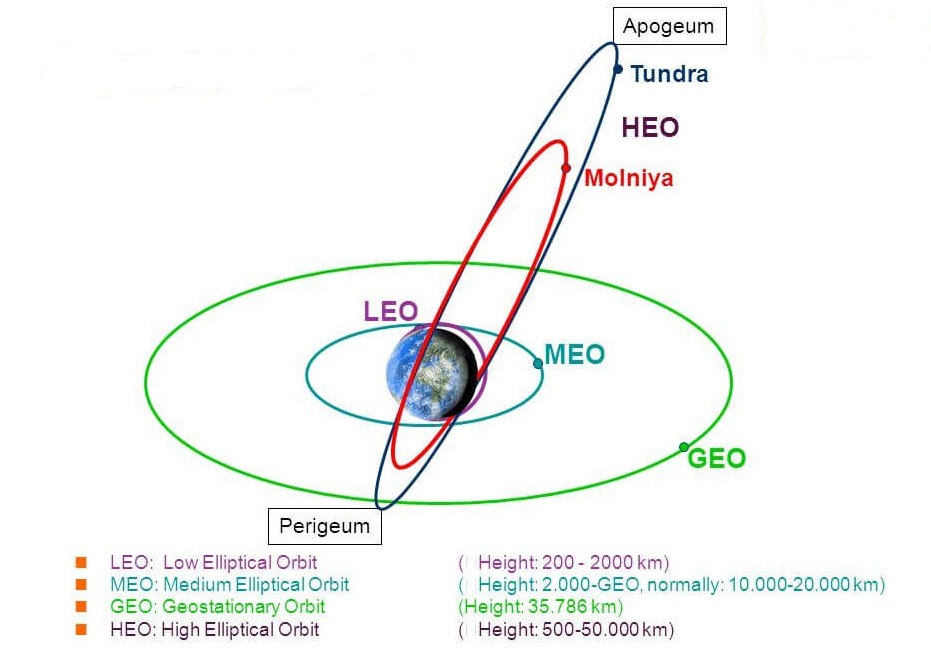Note4Students
From UPSC perspective, the following things are important :
Prelims level: Tundra Satellite, Various types of Orbits
Mains level: Not Much
Russia has successfully placed into orbit a military satellite believed to be part of the Kremlin’s early warning anti-missile system. This launch could be delivering a Tundra satellite.
Tundra Satellite
- The Tundra or EKS (Edinaya Kosmicheskaya Sistema) series of satellites is the next generation of Russian early-warning satellites.
- The development of the EKS started in 2000.
- These satellites carry a secure emergency communications payload to be used in case of a nuclear war.
- They are launched on Soyuz-2-1b Fregat boosters into Molniya-orbits, inclined highly elliptical 12 h orbits.
What are Tundra Orbits?

- A Tundra orbit is a highly elliptical geosynchronous orbit with a high inclination (approximately 63.4°), an orbital period of one sidereal day.
- A satellite placed in this orbit spends most of its time over a chosen area of the Earth, a phenomenon known as apogee dwell.
- It makes satellites particularly well suited for communications satellites serving high latitude regions.
- The ground track of a satellite in a Tundra orbit is a closed figure 8 with a smaller loop over either the northern or southern hemisphere.
- This differentiates them from Molniya orbits designed to service high-latitude regions, which have the same inclination but half the period and do not hover over a single region.
Back2Basics: Types of Orbits
[1] Geostationary orbit (GEO)
- Satellites in geostationary orbit (GEO) circle Earth above the equator from west to east following Earth’s rotation – taking 23 hours 56 minutes and 4 seconds – by travelling at exactly the same rate as Earth.
- This makes satellites in GEO appear to be ‘stationary’ over a fixed position.
- In order to perfectly match Earth’s rotation, the speed of GEO satellites should be about 3 km per second at an altitude of 35 786 km.
- This is much farther from Earth’s surface compared to many satellites.
- GEO is used by satellites that need to stay constantly above one particular place over Earth, such as telecommunication satellites.
- Satellites in GEO cover a large range of Earth so as few as three equally-spaced satellites can provide near-global coverage.
[2] Low Earth orbit (LEO)
- A low Earth orbit (LEO) is, as the name suggests, an orbit that is relatively close to Earth’s surface.
- It is normally at an altitude of less than 1000 km but could be as low as 160 km above Earth – which is low compared to other orbits, but still very far above Earth’s surface.
- Unlike satellites in GEO that must always orbit along Earth’s equator, LEO satellites do not always have to follow a particular path around Earth in the same way – their plane can be tilted.
- This means there are more available routes for satellites in LEO, which is one of the reasons why LEO is a very commonly used orbit.
- It is most commonly used for satellite imaging, as being near the surface allows it to take images of higher resolution.
- Satellites in this orbit travel at a speed of around 7.8 km per second; at this speed, a satellite takes approximately 90 minutes to circle Earth.
[3] Medium Earth orbit (MEO)
- Medium Earth orbit comprises a wide range of orbits anywhere between LEO and GEO.
- It is similar to LEO in that it also does not need to take specific paths around Earth, and it is used by a variety of satellites with many different applications.
- It is very commonly used by navigation satellites, like the European Galileo system of Europe.
- It uses a constellation of multiple satellites to provide coverage across large parts of the world all at once.
[4] Polar Orbit
- Satellites in polar orbits usually travel past Earth from north to south rather than from west to east, passing roughly over Earth’s poles.
- Satellites in a polar orbit do not have to pass the North and South Pole precisely; even a deviation within 20 to 30 degrees is still classed as a polar orbit.
- Polar orbits are a type of low Earth orbit, as they are at low altitudes between 200 to 1000 km.
[5] Sun-synchronous orbit (SSO)
- SSO is a particular kind of polar orbit. Satellites in SSO, travelling over the polar regions, are synchronous with the Sun.
- This means they are synchronised to always be in the same ‘fixed’ position relative to the Sun.
- This means that the satellite always visits the same spot at the same local time.
- Often, satellites in SSO are synchronised so that they are in constant dawn or dusk – this is because by constantly riding a sunset or sunrise, they will never have the Sun at an angle where the Earth shadows them.
- A satellite in a Sun-synchronous orbit would usually be at an altitude of between 600 to 800 km. At 800 km, it will be travelling at a speed of approximately 7.5 km per second.
[6] Transfer orbits and geostationary transfer orbit (GTO)
- Transfer orbits are a special kind of orbit used to get from one orbit to another.
- Often, the satellites are instead placed on a transfer orbit: an orbit where, by using relatively little energy from built-in motors, the satellite or spacecraft can move from one orbit to another.
- This allows a satellite to reach, for example, a high-altitude orbit like GEO without actually needing the launch vehicle.
- Reaching GEO in this way is an example of one of the most common transfer orbits, called the geostationary transfer orbit (GTO).
UPSC 2022 countdown has begun! Get your personal guidance plan now! (Click here)
Get an IAS/IPS ranker as your 1: 1 personal mentor for UPSC 2024
